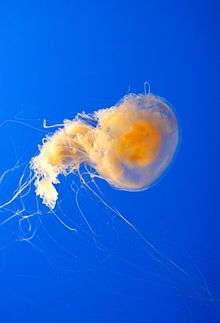Phacellophora camtschatica
| Phacellophora camtschatica | |
|---|---|
 | |
| Scientific classification | |
| Kingdom: | Animalia |
| Phylum: | Cnidaria |
| Class: | Scyphozoa |
| Order: | Semaeostomeae |
| Family: | Phacellophoridae |
| Genus: | Phacellophora |
| Species: | P. camtschatica |
| Binomial name | |
| Phacellophora camtschatica Brandt, 1835 | |
Phacellophora camtschatica, known as the fried egg jellyfish, egg-yolk jellyfish, or the ecehb jellyfish, is a very large jellyfish, with a bell up to 60 cm (2 ft) in diameter and 16 clusters of up to a few dozen tentacles, each up to 6 m (20 ft) long. It has traditionally been included in the family Ulmaridae, but is now considered the only member of the family Phacellophoridae.[1]
This cool-water species can be found in many parts of the world's oceans. It feeds mostly on smaller jellyfish and other gelatinous zooplankton, which become ensnared in the tentacles.[2] Because the sting of this jellyfish is so weak, many small crustaceans, including larval crabs (Cancer gracilis) and Amphipoda, regularly ride on its bell and even steal food from its oral arms and tentacles.[3] The lifecycle of this jellyfish is well known,[4] because it is kept in culture at the Monterey Bay Aquarium. It alternates between a benthic stage attached to rocks and piers that reproduces asexually and the planktonic stage that reproduces sexually in the water column; both males and females occur in the plankton.
A smaller jellyfish, Cotylorhiza tuberculata, typically found in warmer water, particularly in the Mediterranean Sea, is also popularly called a fried egg jellyfish.
References
- ↑ Straehler-Pohl, I., C. L. Widmer, and A. C. Morandini (2011). Characterizations of juvenile stages of some semaeostome Scyphozoa (Cnidaria), with recognition of a new family (Phacellophoridae). Zootaxa 2741: 1–37
- ↑ Strand, S. W. & W.M. Hamner, 1988. Predatory behavior of Phacellophora camtschatica and size-selective predation upon Aurelia aurita (Scyphozoa: Cnidaria) in Saanich Inlet, British Columbia. Marine Biology, 99: 409–414.
- ↑ Towanda, T. & E.V. Thuesen, 2006. Ectosymbiotic behavior of Cancer gracilis and its trophic relationships with its host Phacellophora camtschatica and the parasitoid Hyperia medusarum. Marine Ecology Progress Series, 315: 221–236.
- ↑ Widmer, C.L., 2006. Lifecycle of Phacellophora camtschatica (Cnidaria: Scyphozoa). Invertebrate Biology, 125: 83–90.